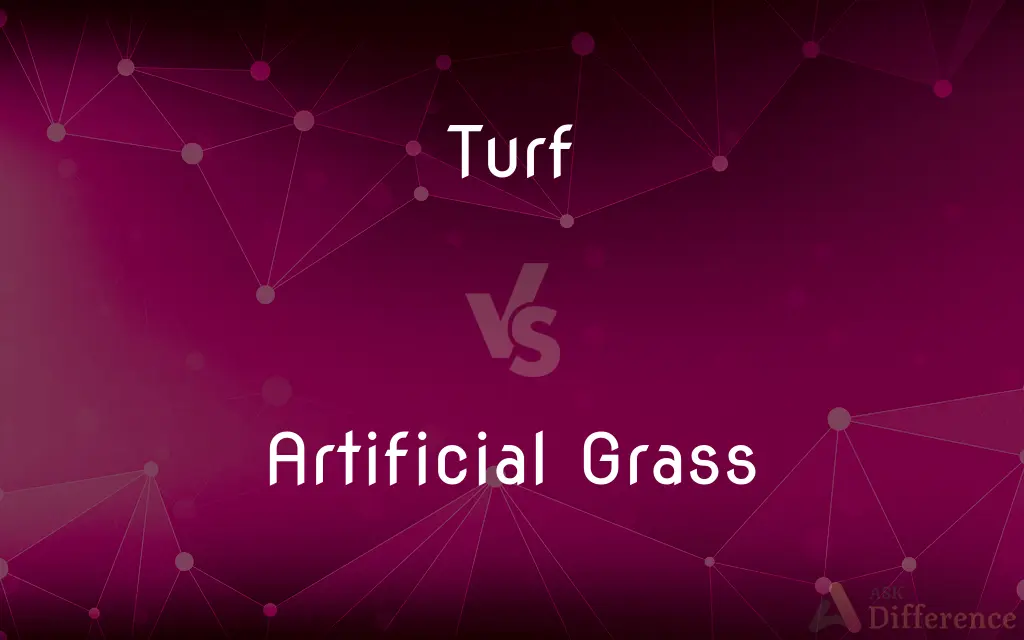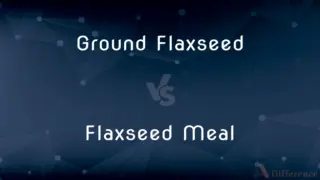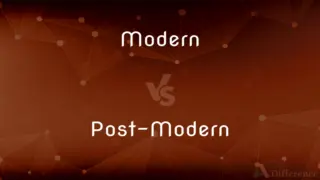Turf vs. Artificial Grass — What's the Difference?
By Tayyaba Rehman & Urooj Arif — Published on March 4, 2024
Turf refers to the upper layer of soil with its dense grass growth, natural and requiring maintenance, while artificial grass, synthetic, offers low maintenance, mimicking the look of real grass without natural growth.

Difference Between Turf and Artificial Grass
Table of Contents
ADVERTISEMENT
Key Differences
Turf, often called natural grass, is a living ground cover used in gardens, sports fields, and landscaping for its natural appearance and feel. It requires regular maintenance, including watering, mowing, and fertilization, to remain healthy and aesthetically pleasing. Artificial grass, made from synthetic fibers, is designed to look like real grass but without the upkeep. It's popular in areas where water conservation is essential or where grass maintenance is challenging.
The installation process for turf involves preparing the soil, laying the grass sod or seeding, and ensuring proper growth conditions. This can be labor-intensive and requires ongoing care to establish. Artificial grass installation is more about setting a durable base and rolling out the synthetic material, which can be more straightforward but requires precise preparation to avoid issues like poor drainage or uneven surfaces.
Turf's natural growth contributes to a healthy ecosystem, providing oxygen, supporting biodiversity, and helping with temperature regulation and water filtration. Artificial grass does not offer these environmental benefits but can be suitable for places facing water shortages, as it requires no irrigation or fertilizers, reducing water use and chemical runoff.
The aesthetic and functional aspects of turf are hard to match, with its natural look, feel, and ability to repair itself. However, it can be susceptible to weeds, pests, and diseases, requiring treatments that may impact the environment. Artificial grass provides a consistently green and manicured appearance year-round, with no risk of weeds or pests, though it can feel less natural and may heat up more in direct sunlight.
The cost factor varies significantly between the two options. Turf, while cheaper to install, incurs ongoing costs for water, maintenance, and repairs. Artificial grass demands a higher initial investment but offers lower long-term costs due to minimal maintenance requirements, making it an economical choice over time for those willing to compromise on the natural benefits of turf.
ADVERTISEMENT
Comparison Chart
Composition
Living grass plants
Synthetic fibers
Maintenance
High (watering, mowing, fertilization)
Low (occasional cleaning)
Environmental Impact
Positive (oxygen production, supports biodiversity)
Mixed (reduces water use, but non-biodegradable)
Installation
Labor-intensive, requires soil preparation
Straightforward but needs precise base preparation
Cost
Lower initial, higher ongoing
Higher initial, lower ongoing
Compare with Definitions
Turf
A living ground cover that requires regular maintenance.
He mowed the turf weekly to keep it looking neat.
Artificial Grass
Synthetic fibers designed to mimic real grass.
They installed artificial grass to reduce yard maintenance chores.
Turf
Can repair itself and supports biodiversity.
The natural turf was a habitat for a variety of insects and birds.
Artificial Grass
Provides a year-round green appearance.
The artificial grass looked lush and green, even in the middle of summer.
Turf
Benefits ecosystems by producing oxygen.
The turf in their backyard created a cooler, more pleasant outdoor environment.
Artificial Grass
Easy to clean and maintain.
A quick rinse was all it took to clean the artificial grass after a barbecue.
Turf
Needs watering and fertilization.
She scheduled the sprinkler system to ensure the turf was adequately watered.
Artificial Grass
Can heat up in direct sunlight.
They chose a shaded area for the artificial grass to avoid it getting too hot.
Turf
Susceptible to weeds and pests.
They applied an eco-friendly pesticide to their turf to control the grub infestation.
Artificial Grass
Requires no watering, mowing, or fertilization.
Their water bill decreased significantly after switching to artificial grass.
Turf
A surface layer of earth containing a dense growth of grass and its matted roots; sod.
Turf
An artificial substitute for such a grassy layer, as on a playing field.
Turf
A piece cut from a layer of earth or sod.
Turf
(countable) A piece of such a layer cut from the soil. May be used as sod to make a lawn, dried for peat, stacked to form earthen structures, etc.
Turf
Surface layer of ground containing a matt of grass and grass roots
Turf
Cover (the ground) with a surface layer of grass or grass roots
Common Curiosities
How long does artificial grass last?
Quality artificial grass can last 15 to 25 years, depending on usage and maintenance.
Does natural turf have any environmental benefits?
Yes, it produces oxygen, supports biodiversity, helps with temperature regulation, and can filter rainwater.
Can artificial grass look as good as natural turf?
High-quality artificial grass can closely mimic the look of natural turf, though the feel and environmental benefits may differ.
What maintenance does natural turf require?
Watering, mowing, fertilization, and pest control are essential for keeping natural turf healthy.
Is artificial grass suitable for pets?
Yes, many types are pet-friendly, easy to clean, and resistant to damage from pets.
What is the main difference between turf and artificial grass?
Turf is natural, living grass requiring regular maintenance, while artificial grass is a synthetic, low-maintenance alternative.
Is artificial grass environmentally friendly?
While it reduces water use and chemical runoff, its synthetic composition is not biodegradable, presenting disposal concerns.
What are the cost implications of choosing turf over artificial grass?
Turf has lower initial costs but higher ongoing maintenance expenses, whereas artificial grass requires a higher initial investment but minimal maintenance costs.
Do I need to prepare the ground for artificial grass?
Yes, ground preparation, including leveling and installing a suitable base, is crucial for long-term performance.
Can I install artificial grass myself?
DIY installation is possible, but professional installation ensures proper drainage and a level surface.
How do I choose between turf and artificial grass?
Consider factors like maintenance, environmental impact, usage, and budget to decide which option best suits your needs.
How does weather affect natural turf and artificial grass?
Natural turf can be impacted by drought, excessive rain, or frost, while artificial grass is largely unaffected by weather conditions.
Can artificial grass improve my property value?
It can enhance curb appeal and reduce maintenance concerns, potentially increasing property value.
Is it possible to repair damaged artificial grass?
Minor damages can be patched or repaired, though significant issues may require replacement of the affected area.
Are there different types of artificial grass?
Yes, artificial grass comes in various blade lengths, colors, and materials to suit different preferences and uses.
Share Your Discovery

Previous Comparison
Ground Flaxseed vs. Flaxseed Meal
Next Comparison
Modern vs. Post-ModernAuthor Spotlight
Written by
Tayyaba RehmanTayyaba Rehman is a distinguished writer, currently serving as a primary contributor to askdifference.com. As a researcher in semantics and etymology, Tayyaba's passion for the complexity of languages and their distinctions has found a perfect home on the platform. Tayyaba delves into the intricacies of language, distinguishing between commonly confused words and phrases, thereby providing clarity for readers worldwide.
Co-written by
Urooj ArifUrooj is a skilled content writer at Ask Difference, known for her exceptional ability to simplify complex topics into engaging and informative content. With a passion for research and a flair for clear, concise writing, she consistently delivers articles that resonate with our diverse audience.
















































